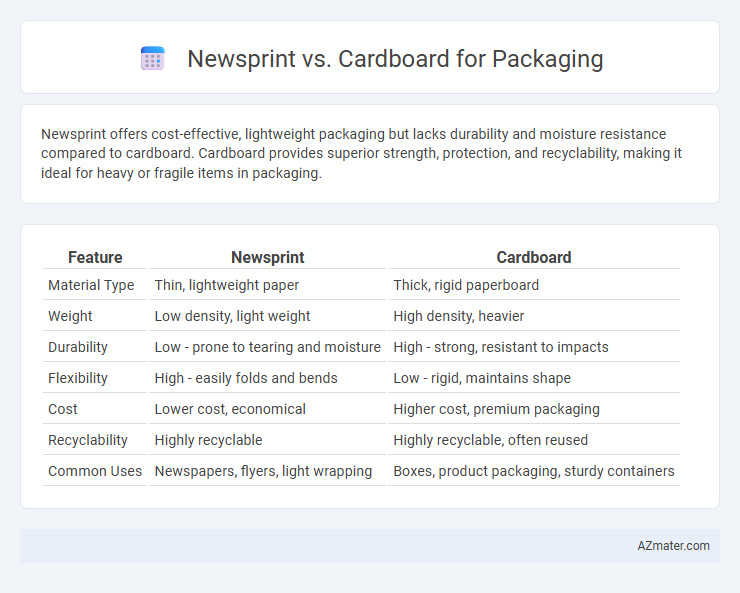Newsprint offers cost-effective, lightweight packaging but lacks durability and moisture resistance compared to cardboard. Cardboard provides superior strength, protection, and recyclability, making it ideal for heavy or fragile items in packaging.
Table of Comparison
| Feature | Newsprint | Cardboard |
|---|---|---|
| Material Type | Thin, lightweight paper | Thick, rigid paperboard |
| Weight | Low density, light weight | High density, heavier |
| Durability | Low - prone to tearing and moisture | High - strong, resistant to impacts |
| Flexibility | High - easily folds and bends | Low - rigid, maintains shape |
| Cost | Lower cost, economical | Higher cost, premium packaging |
| Recyclability | Highly recyclable | Highly recyclable, often reused |
| Common Uses | Newspapers, flyers, light wrapping | Boxes, product packaging, sturdy containers |
Introduction: Comparing Newsprint and Cardboard for Packaging
Newsprint and cardboard serve distinct roles in packaging, with newsprint known for its lightweight, flexible nature primarily used in protective wrapping and cushioning. Cardboard, available in varieties like corrugated and paperboard, offers superior structural strength, making it ideal for shipping boxes and rigid containers. Evaluating factors such as durability, cost-effectiveness, and environmental impact helps determine the optimal material for specific packaging needs.
Material Composition: Newsprint vs Cardboard
Newsprint is composed primarily of low-cost, uncoated, and lightweight wood pulp fibers, making it less durable but highly recyclable. Cardboard consists of multiple layers of paper pulp, often including recycled materials, resulting in a thicker, sturdier, and more rigid structure ideal for protective packaging. The higher fiber density and layering in cardboard contribute to superior strength and resistance to moisture compared to the thin, porous nature of newsprint.
Durability and Strength Factors
Newsprint offers limited durability and strength for packaging due to its thin, low-density fibers that easily tear under stress. Cardboard, especially corrugated varieties, provides superior structural integrity with multiple layers designed to absorb impact and resist punctures. The enhanced rigidity and cushioning properties of cardboard make it ideal for protecting heavier or fragile items during transit.
Cost-Effectiveness Analysis
Newsprint offers a lower cost per unit compared to cardboard, making it ideal for budget-sensitive packaging applications. However, cardboard provides superior durability and protection, which can reduce product damage costs and improve overall value in transit. Choosing between newsprint and cardboard hinges on balancing upfront material expenses against long-term savings from enhanced product safety.
Environmental Impact and Sustainability
Newsprint packaging uses recycled fibers, reducing deforestation and lowering carbon emissions compared to virgin paper production, but it is less durable and water-resistant than cardboard. Cardboard, particularly corrugated varieties, offers enhanced strength and protection with higher recyclability rates, supporting circular economy goals and often incorporating post-consumer recycled content. Choosing between newsprint and cardboard depends on balancing environmental impact factors such as biodegradability, resource intensity, and end-of-life recyclability aligned with sustainable packaging objectives.
Printability and Branding Opportunities
Newsprint offers excellent printability with its smooth surface, enabling vivid and detailed graphics that enhance branding opportunities for short-term promotions or cost-effective packaging. Cardboard provides a sturdier substrate with a slightly rougher texture, supporting high-quality print finishes such as embossing and spot UV, which elevate brand perception and durability for premium packaging. Both materials serve distinct branding needs: newsprint excels in affordability and quick, visually striking prints, while cardboard delivers strength and sophisticated print effects for lasting brand impact.
Weight and Shipping Considerations
Newsprint is lightweight and flexible, making it ideal for packaging that requires minimal weight to reduce shipping costs. Cardboard offers greater structural integrity and higher weight, providing superior protection but potentially increasing shipping expenses due to added bulk. Balancing packaging requirements with transportation efficiency is crucial when choosing between newsprint and cardboard materials.
Protection and Cushioning Capabilities
Newsprint offers lightweight cushioning ideal for wrapping fragile items, providing moderate protection against scratches and surface damage. Cardboard delivers superior protection with its rigid structure, effectively absorbing shocks and preventing deformation during transit. Choosing cardboard enhances packaging durability and cushioning, especially for heavier or more delicate products requiring robust protection.
Recycling and Disposal Options
Newsprint offers excellent recyclability due to its high fiber content and ability to be reprocessed multiple times, making it an eco-friendly choice for packaging. Cardboard is widely accepted in recycling programs and can be composted when free of coatings, but its thicker layers may require more energy to break down during recycling. Both materials provide sustainable disposal options, yet newsprint generally has a lower environmental footprint in the recycling stream compared to cardboard.
Choosing the Right Packaging Material
Choosing the right packaging material depends on the product's weight, durability requirements, and environmental impact. Newsprint offers cost-effective, lightweight protection ideal for wrapping or cushioning fragile items, while cardboard provides robust structural support suited for shipping heavy or bulky goods. Evaluating factors like recyclability, strength, and printability helps determine whether newsprint or cardboard best meets packaging needs.

Infographic: Newsprint vs Cardboard for Packaging
 azmater.com
azmater.com